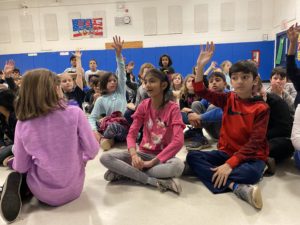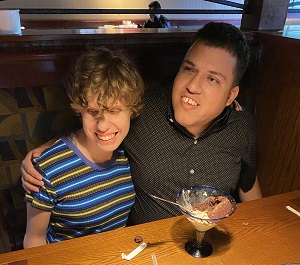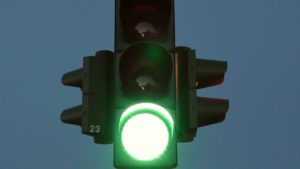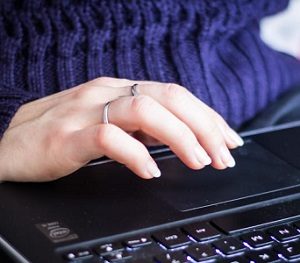Inclusion Begins with the Youth: On Educating Kids about Disability
by Beth Finke

Photo of then-new Seeing Eye dog Luna’s first and last in-person school visits in early March, 2020, before you-know-what happened.
During presentations I give about disability awareness, one thing I like to get across to the school kids is that people with disabilities enjoy — and engage in — a lot of the same things they do. We just develop different skills (and sometimes use different “helping tools”) to achieve our goals.
This past May, Luna and I did what will likely be our last Zoom presentation for 3rd graders this school year. Our presentation was scheduled for late morning, and the weather was so beautiful in Chicago that a dear neighbor had invited me to come swim laps at his condominium’s outdoor pool around noon.
Could I make it to my friend’s pool on time? Well, yes. As long as I wore my swimsuit to the presentation. The 3rd graders would only see my head and shoulders on Zoom, right?
My Zoom talk that morning opened with a big announcement: this would mark the first time I’ve ever worn a swimsuit to a school presentation. The kids were all muted, and without being able to see them, I chose to believe they found that absolutely hilarious. “Right after this presentation is over, I’m going swimming outside!”
My mentioning swimsuits and swimming provided an instant connection between me and these very bright eight and nine-year-olds. Some of their questions:
- How long have you been swimming?
- What was your favorite activity when you could see, and what is your favorite activity now
- Where’d you learn to swim?
- How can you Zoom if you can’t see?
- How can you drive?
- How many Seeing Eye dogs have you had?
- Did any of your dog’s ever bite someone?
- Have any of your dog’s gotten sick?
- Did you ever use a stick?
- How many books have you wrote?
- Are you writing any books now?
- Did you write those books when you were blind, or did you write them all when you were like us and still in school and you could see?
- Did you have to learn a lot of new things after you were blind?
- How many years have you been blind?
- How many years have you been swimming?
Doing Zoom presentations from the comforts of home has its benefits: no need to arrange for rides to faraway suburban schools, don’t have to wake up early, it’s okay to dress casual, you don’t have to pack up your “helping tools” to bring along, Zooming takes less time, allowing the Zoomer to fit more things into their day…like swimming laps outside.
And yet.
I still prefer being in the room with the kids I’m visiting. I miss hearing their ‘ooh’s and ‘ah’s when my Seeing Eye dog leads me into their classroom, the murmur of questions they ask even before the presentation begins, hearing “me! Me! Me!” when they hold up their hands to ask questions afterwards, and, especially, the joy they express when I take Luna’s harness off afterwards and let them pet her. I’m holding out hope that at least some of the visits to schools next year will be in person, but who knows? Maybe the schools will decide sponsoring Zoom meetings for authors is easier for them. Like so many other issues during these pre-post-pandemic times, I guess we’ll just have to wait and see.
Or wait and hear!








 At Easterseals, we believe in the power of the disability community, the unlimited potential of some 61 million Americans with disabilities. It’s undeniable. And yet, far too many adults with disabilities remain under- or unemployed, with businesses and others in our communities still failing to tap this incredible pool of talent.
At Easterseals, we believe in the power of the disability community, the unlimited potential of some 61 million Americans with disabilities. It’s undeniable. And yet, far too many adults with disabilities remain under- or unemployed, with businesses and others in our communities still failing to tap this incredible pool of talent.

 I just got word that the U.S. Department of Justice has
I just got word that the U.S. Department of Justice has 

